|
In August 1973 (the 18th), I
was just turning 15 years old and could only dream of owning an R/C airplane, much
less an R/C helicopter. It was still a time when very few people possessed the skill
or money to become proficient enough at flying helis to consider competing in a
contest. There were no programmable radios, and the metal-to-metal contact of gears
and mechanical connections wreaked havoc on the 72 MHz receivers. Gyros were of
the Hiller mechanical type; piezoelectric versions that integrated with the tail
rotor servo were yet to be invented. Many of the models that appeared at the 1973
Helicopter Nationals were either entirely home built, or modified from a standard
kit. Having struggled with a DuBro
TriStar helicopter myself in the late 1970s, I can attest to the difficulty
posed by trying to keep the tail under control when engine speed changed, which
was constantly since fixed pitch was the rule of the day. Thank goodness for modern
inventions that allow just about anyone to successfully an R/C helicopter!
RC Helicopter Nats
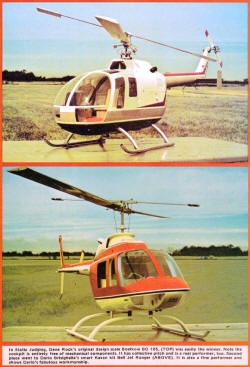 Photos by John Burkam and Gene Rock Photos by John Burkam and Gene Rock
In Static Judging, Gene Rock's original design scale Boelkow BO 105, (TOP) was
easily the winner. Note the cockpit is entirely free of mechanical components. It
has collective pitch and is a real performer, too. Second place went to Dario Brisighella's
smart Kavan kit Bell Jet Ranger (left). It Is also a fine performer and shows Dario's
fabulous workmanship.
More than 20 modelers competed in the five events with a good variety of designs.
Flying was excellent in spite of very windy conditions. / by Gene Rock
The Second Annual RC Model Helicopter Nationals were held at Fond du Lac (Wisconsin)
Airport on August 9 and 10. Fond du Lac proved to be an excellent site. It was only
15 minutes from Oshkosh, where the Model Airplane Nationals were being held, it
was easily accessible, it had good motel accommodations, and the wind was from across
the field. In fact, the weather, quite similar to last year's, was warm, sunny and
windy.
Originally the contest was to be a set of precision maneuvers but, due to a lack
of qualified judges, it was changed to a race against the clock in four events.
The first was a ten-ft. constant heading square with a landing at each corner. The
second was a cargo pickup in which each contestant was to pick up a hoop and carry
it to a landing pad 30 ft. away. Third was a Figure Eight around two pylons 50 ft.
apart crosswind. Fourth, was Solo Pylon Racing with two pylons 100 ft. apart placed
with the wind and one pylon crosswind on the left. A fifth flying event (not against
the clock) was Expert's Choice with each pilot listing his maneuvers and performing
them in sequence. All events had a five-min. time limit.
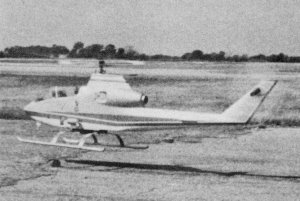
Walt Schoonard's big, attractive Cobra which placed third in
Scale, has one of the nicest civilian color schemes seen on a Cobra.
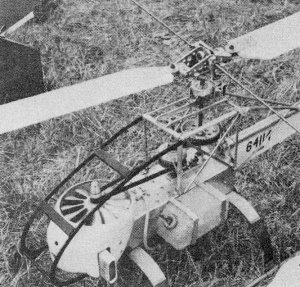
Along with his fabulous scale model, Gene Rock brought along
his SSP·S to fly in some of the Maneuvering events.
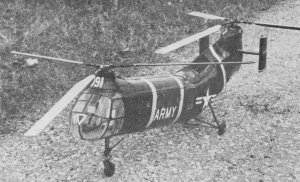
Al Doucette's magnificent CH-21C Tandem. The model works, has
a Wankle engine and all control systems are scale, but even after five years of
work, the radio is not yet installed. He plans to learn to fly choppers with a kit
before trying his scale model.
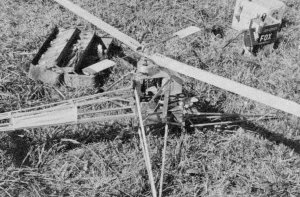
Dave Youngblood's original design model is an exceptionally easy
to fly model even in strong winds.
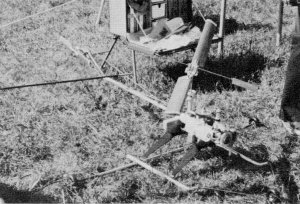
Fay Peoples' much modified 2B placed first in the Non-scale Static
event.
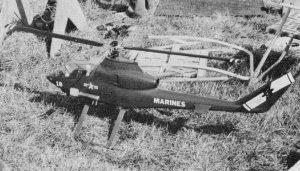
Steve Darlington's Kalt Huey Cobra with the rigid head flew smoothly
for him even in the strong winds.
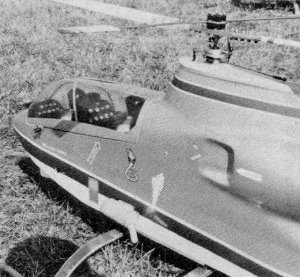
Close-up of Schoonard's Cobra. Imagine operating one of these
for civilian use without armament, heavy protective skins, etc.
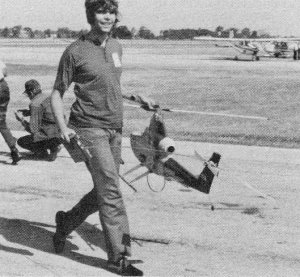
Tom Herr, youngest contestant, displayed respect for his model
and good sportsmanship by not flying in events in which he felt he was not competitive.
We all thought he flew quite well in other events.
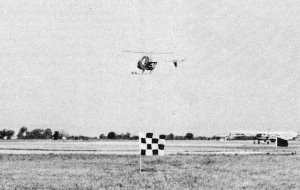
Hughes 300 by Du-Bro (one of many Du-Bro versions) in the Figure
Eight event.
Twenty-one pilots turned out to pit their models against the hazardous first four
events. This flying tends to eliminate models and/or pilots when a wind of 15 mph
or greater is blowing. Toward the end of the second day, the field of models thinned
considerably. Luckily, there were no crashes that proved fatal to any models involved.
The first event, constant heading square, was very heated. Everyone was fresh;
eight of the entries were under 30 sec. Ernie Huber's Schuco-Heqi Huey Cobra came
out on top with an amazing time of 19.7 sec. Bob Bentley flying a Du-Bro Hughes
300 came in second with 23.5 sec. and Dave Keats' Hughes 300 was awarded third place
with 24.1 sec. When any part of the landing gear was on the pad, time was called
provided the model stayed there. This was the easiest and the least frustrating
event, though the wind gave some models problems. In this first event, it became
evident that the Hughes 300 in its scale configuration has a tail wagging problem.
The reason for this is the very small scale sub rudder. Though this can be a problem
for the beginner, it can be resolved by substituting a rudder of approximately three
times the area.
In the next event, four hoops were placed downwind from the landing pad. The
pilot was to pick up one hoop and carry it to the pad. If one was knocked down,
he proceeded to the next; if all four were knocked down, the pilot would land while
the judges set the hoops up again. I know one pilot who took the whole five min.,
knocked down at least 16 hoops and did not score! I won't mention my name.
Dario Brisighella with a Kavan Jet Ranger would have turned in good times if
his model had not slid out of the landing pad for both attempts. A high speed rigid
or spring-loaded rotor seems almost a must for this event. Faye Peoples stuck his
great big training nose-wheel through the hoop like spearing a fish and carried
it to the landing pad in 13 sec. - Fay's third highly modified 2B flew as well as
it looked.
Young AAM editor Ed Sweeney put on a set of old blades he knew worked, fired
up his internal 19-powered converted Du-Bro 505, took off and practically flew through
the hook and carried it to the Landing pad in 14 sec. I think if he had just missed
the hoop, it would have bounced to the pad. Ron Wiensch took third with a Du-Bro
Hughes 300 in 17.5 sec.
The Figure Eight course was the first event of the second day. The number of
scoring entries was down to 12. The pilots soon found more models wandering around
with almost a couple of fly-aways, and one near fatal crash into a movie camera
tripod. Ernie Huber's first round 9f 25 sec. was good enough to win, but his second
round of 21.2 made him unbeatable. Dave Gray, flying a Hughes 300, came in second
with 27 sec. Gene Rock's SSP-5 came in third with 28.4 sec.
The last event against the clock was the most spectacular. The Solo Pylon race
had seven scoring entries. Although the average speed for the course was 20 mph,
speeds of 50 mph were obtained with a 20 mph tail wind, that would have added up
to a 70 mph on the downwind leg. The pylons being so close together meant that the
downwind leg was a constant left turn command and therefore not much faster than
the upwind one, At least two models hit the deck on the upwind leg, bounced back
up and continued to fly. The upwind leg seemed to be a severe dive for most models
except the Huey Cobras. Ernie Huber again came out on top with 37.6 sec. Dave Keats
at 39.2 sec. won the second spot and third was Bob Bentley with 40.2. The Huey Cobra
seems to be a faster model than the Hughes 300, but the pylons being so close did
not prove it. Most of the times in this event were very close and those over one
min. usually meant that a pylon was cut.
The last event was Expert's Choice with the pilots required to list their maneuvers.
There was no limit on the number of maneuvers to be done in a five-min. time limit.
Ernie Huber could do no wrong. He hovered into the wind and then to the left
and right followed by S turns into the wind and then a spot landing. He then proceeded
to drag his skids on takeoff, followed by crosswind high speed pass with a hammerhead
turn. He also did a beautiful left slide along with a vertical climb to 50 ft. and
then a vertical descent to a spot landing. During the contest it was found out that
Ernie removed 10 sq. in. from the Huey Cobra's rudder which enabled him to hover
gracefully in a crosswind. Ernie used an as 60 and Kraft equipment.
Dave Youngblood took second place with an excellent flying scratch-built. His
model seemed to hover effortlessly in the strong wind. His square with constant
heading and his stall turn netted his highest scores in this event. Gene Rock took
third still flying the S.S.P.-5 with a tail rotor gyro. The gyro slowed down his
pinwheel and stall turn. The gyro has since been corrected to incorporate higher
yaw rates.
All models entered at the NATS were eligible for static judging in Scale or Non-scale
provided they could fly for at least 15 sec. According to the rules, no modeler
could win or place in both Scale or Non-scale.
In the Non-scale event, Faye People's scratch-built No. 3 highly modified 2B
took first place. The model is two-stage belt driven with a clutch on the intermediate
shaft. The tail rotor is driven by a flexible cable inside an aluminum tube. The
heat sink on the engine was spring-coiled around the head just above the exhaust.
Very ingenious! The fan was simply a two-bladed prop made from sheet aluminum. Every
part had a satin finish including a swirl finish on his sheet aluminum. The model
is powered by a ST 56, and it has a 54-in. dia. rotor, using Kraft six-channel single
stick.
Second place went to Dave Youngblood. His model seems to be a cross between a
2B a SSP. The model is powered by a 60 with a 65-in. dia. rotor using Kraft equipment.
Dave's model flew extremely well; the training landing gear giving him a low center
of drag seems to be its only handicap.
Dave Keats' converted Du-Bro 505 won third place. The 25 internal engine powered
Whirlybird flew all over the sky with graceful Figure Eights and high speed passes,
yet it hardly took more room than a backyard to maneuver.
First place in Scale went to Gene Rock's Boeing Boelkow BO-105. The model is
powered by a Webra 60 turning a 4 1/2 ft. dia. with the tail rotor turning 6900
rpm. Collective pitch is coupled to the tail rotor and is achieved by moving the
Hiller gyro bar vertically. The fuselage is fully monocoque with no bulk-heads or
stringers. The drive system and servos do not interfere with the scale cockpit area.
The cockpit includes a scale pilot, a carpeted floor and wood grained back seat.
The radio equipment is Pro-Line and the finish is six-tone HobbyPoxy. Because neither
this model nor Dave Keats' converted 505 were entered in the flying events, they
flew the 15 sec. minimum flying rule to quality in static judging. Second place
went to Dario Brisighella's beautiful Kavan Jet Ranger. Dario is so meticulous to
scale that his engine was primed through the chrome turbine exhaust pipes. His power
was a Webra 60 complete with working navigational lights and a blinking light for
fuel level. The handling characteristics of the model were very scale-like, especially
the jump takeoffs and precise altitude control. During the contest, it was learned
that offsetting the rudder so that it unloads the tail rotor in forward flight (left
turn) would help solve the right high speed turn problem of the model. Having only
flown this model for two hours previous to the contest prevented Dario from putting
his model through its paces.
Third place was awarded to Walt Schoonard flying a civilian version of the Schuco-Hegi
Huey Cobra. The model was powered by a Veco 61 using a Kavan carburetor. The model
sported a four-tone color scheme including instruments on the control console. Walt's
faulty equipment was overcome by his sheer nerve. Honorable mention goes to Al Doucette
of Texas. His model is the CH-21C tandem rotor. This model was constructed with
such careful attention to detail that it could not be distinguished from the full-scale
bird except for the size. Everything on the model is scale including swashplate,
pitch links, hubs, etc. Al has spent ten years on and off to get his model to this
stage of completion. The model has been tested with a Wankel engine and is waiting
for the radio installation. The 15-sec. time rule prevented Al from taking first
place.
Naturally, the Grand Champion award went to Ernie Huber who had first in the
Constant Heading, Figure Eight, Solo Pylon, and Expert's Choice events. The grand
championship award is an accumulation of all events. Flying skill awards were based
on just the flying: Ernie Huber was awarded first; Faye Peoples, second; and Gene
Rock, third.
Dave Keats brought four models to the NATS. Two which were not mentioned or entered
were the RCH Jet Ranger and a Du-Bro 505. Dave is the third or fourth owner of the
Jet Ranger and has highly modified it to get it back into flying form. Some of the
modifications were a new hub, reworked drive for the swashplate and tail rotor slider.
The gears in the transmission were also repatterned. After all this, the model flew
relatively well, but was somewhat heavy. His Du-Bro 505 was not flown.
Harold Everson displayed his new trainer powered by a Ross twin. Of all the scratch-built,
non-scale, aluminum bodied helicopters that have shown up over the last couple of
years, this one has probably the most pleasing lines. Harold and his son also displayed
their blinking light fuel level system. The light continues to blink until the fuel
is low or there is a power failure. He also displayed rod ends that far surpass
the quality of any other available on the market. His price is around $16 for the
fuel level indicator and $1.25 for his rod end. Address: Harold Everson, 224 N.
Rankin St., Appleton, Wisc. 54911.
Steve Darlington flew a Kalt Huey Cobra powered by an Enya 45. The model featured
a rigid rotor and handled extremely well in the wind.
On the afternoon of the second day, many of the sun-burnt pilots anxiously awaited
the judges' final decisions. Some pilots flew to pass the time while others talked
about the type of contest they would like to see in the future. At least three types
of contests have evolved in the past two years: Clock, Precision and Free Style.
If everyone involved would submit in writing their preference to John Burkam before
next year's NATS, maybe this problem could be resolved. We need to submit the type
of contest and the kinds of maneuvers we all would like to the AMA board next year
at the Model Airplane NATS to be recognized by AMA in 1975.
All of us involved wish to extend our thanks to John Burkam and Dale Willoughby.
Without John Burkam's perseverance, this contest would not have been held.
Posted December 10, 2022
(updated from original
post on 10/1/2011)
|




